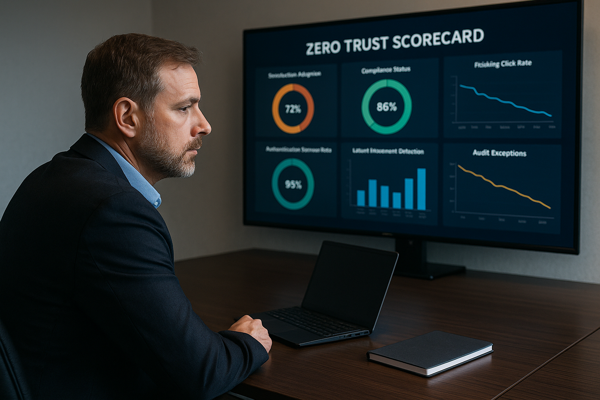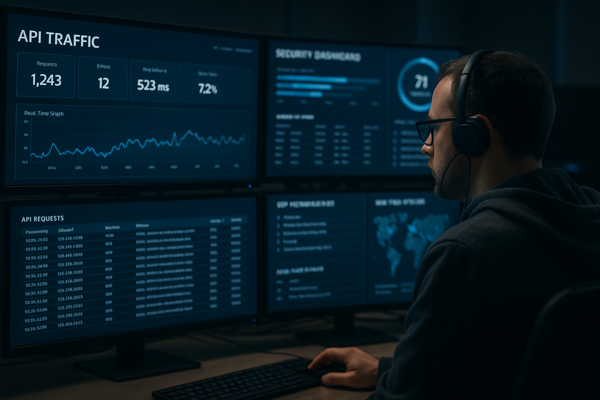Imagine this: a data science team is evaluating a public generative AI API to help with summarization of documents. One engineer—trying to accelerate prototyping—uploads a dataset containing customer PII (names, addresses, payment tokens) without anonymization. The API ingests that data. Later, another user submits a prompt that triggers portions of the PII to be regurgitated in an output. The leakage reaches customers, regulators, and media.
This scenario is not hypothetical. As enterprise adoption of generative AI accelerates, organizations are discovering that the boundary between internal data and external AI systems is porous—and many have no governance guardrails in place.

According to a recent report, ~89% of enterprise generative AI usage is invisible to IT oversight—that is, it bypasses sanctioned channels entirely. Another survey finds that nearly all large firms deploying AI have seen risk‑related losses tied to flawed outputs, compliance failures, or bias.
The time to move from opportunistic pilots toward robust governance and security is now. In this post I map the risk taxonomy, expose gaps, propose controls and governance models, and sketch a maturity roadmap for enterprises.
Risk Taxonomy
Below I classify major threat vectors for AI / generative AI in enterprise settings.
1. Model Poisoning & Adversarial Inputs
-
Training data poisoning: attackers insert malicious or corrupted data into the training set so that the model learns undesirable associations or backdoors.
-
Backdoor / trigger attacks: a model behaves normally unless a specific trigger pattern (e.g. a token or phrase) is present, which causes malicious behavior.
-
Adversarial inputs at inference time: small perturbations or crafted inputs cause misclassification or manipulation of model outputs.
-
Prompt injection / jailbreaking: an end user crafts prompts to override constraints, extract internal context, or escalate privileges.
2. Training Data Leakage
-
Sensitive training data (proprietary IP, PII, trade secrets) may inadvertently be memorized by large models and revealed via probing.
-
Even with fine‑tuning, embeddings or internal layers might leak associations that can be reverse engineered.
-
Leakage can also occur via model updates, snapshots, or transfer learning pipelines.
3. Inference-Time Output Attacks & Leakage
-
Model outputs might infer relationships (e.g. “given X, the missing data is Y”) that were not explicitly in training but learned implicitly.
-
Large models can combine inputs across multiple queries to reconstruct confidential data.
-
Malicious users can sample outputs exhaustively or probe with adversarial prompts to elicit sensitive data.
4. Misuse & “Shadow AI”
-
Shadow AI: employees use external generative tools outside IT visibility (e.g. via personal ChatGPT accounts) and paste internal documents, violating policy and leaking data.
-
Use of unconstrained AI for high-stakes decisions without validation or oversight.
-
Automation of malicious behaviors (fraud, social engineering) via internal AI capabilities.
5. Compliance, Privacy & Governance Risks
-
Violation of data protection regulations (e.g. GDPR, CCPA) via improper handling or cross‑boundary transfer of PII.
-
In regulated industries (healthcare, finance), AI outputs may inadvertently produce disallowed inferences or violate auditability requirements.
-
Lack of explainability or audit trails makes it hard to prove compliance or investigate incidents.
-
Model decisions may reflect bias, unfairness, or discriminatory patterns that trigger regulatory or reputational liabilities.
Gaps in Existing Solutions
-
Traditional security tooling is blind to AI risks: DLP, EDR, firewall rules do not inspect semantic inference or prompt-based leakage.
-
Lack of visibility into model internals: Most deployed models (especially third‑party or foundation models) are black boxes.
-
Sparse standards & best practices: While frameworks exist (NIST AI RMF, EU AI Act, ISO proposals), concrete guidance for securing generative AI in enterprises is immature.
-
Tooling mismatch: Many AI governance tools are nascent and do not integrate smoothly with existing enterprise security stacks.
-
Team silos: Data science, DevOps, and security often operate in silos. Defects emerge at the intersection.
-
Skill and resource gaps: Few organizations have staff experienced in adversarial ML, formal verification, or privacy-preserving AI.
-
Lifecycle mismatch: AI models require continuous retraining, drift detection, versioning—traditional security is static.
Governance & Defensive Strategies
Below are controls, governance practices, and architectural strategies enterprises should consider.
AI Risk Assessment / Classification Framework
-
Inventorize all AI / ML assets (foundation models, fine‑tuned models, inference APIs).
-
Classify models by risk tier (e.g. low / medium / high) based on sensitivity of inputs/outputs, business criticality, and regulatory impact.
-
Map threat models for each asset: e.g. poisoning, leakage, adversarial use.
-
Integrate this with enterprise risk management (ERM) and vendor risk processes.
Secure Development & DevSecOps for Models
-
Embed adversarial testing, fuzzing, red‑teaming in model training pipelines.
-
Use data validation, anomaly detection, outlier filtering before ingesting training data.
-
Employ version control, model lineage, and reproducibility controls.
-
Build a “model sandbox” environment with strict controls before production rollout.
Access Control, Segmentation & Audit Trails
-
Enforce least privilege access for training data, model parameters, hyperparameters.
-
Use role-based access control (RBAC) and attribute-based access (ABAC) for model execution.
-
Maintain full audit logging of prompts, responses, model invocations, and guardrails.
-
Segment model infrastructure from general infrastructure (use private VPCs, zero trust).
Privacy / Sanitization Techniques
-
Use differential privacy to add noise and limit exposure of individual records.
-
Use secure multiparty computation (SMPC) or homomorphic encryption for sensitive computations.
-
Apply data anonymization / tokenization / masking before use.
-
Use output filtering / content policies to supersede model outputs that might leak or violate policy.
Monitoring, Anomaly Detection & Runtime Guardrails
-
Monitor model outputs for anomalies, drift, suspicious prompting patterns.
-
Use “canary” prompts or test probes to detect model corruption or behavior shifts.
-
Rate-limit or throttle requests to model endpoints.
-
Use AI-defense systems to detect prompt injection or malicious patterns.
-
Flag or block high-risk output paths (e.g. outputs that contain PII, internal config, backdoor triggers).
Operational Integration
Security–Data Science Collaboration
-
Embed security engineers in the AI development lifecycle (shift-left).
-
Educate data scientists in adversarial ML, model risks, privacy constraints.
-
Use cross-functional review boards for high-risk model deployments.
Shadow AI Discovery & Mitigation
-
Monitor outbound traffic or SaaS logins for generative AI usage.
-
Use SaaS monitoring tools or proxy policies to intercept and flag unsanctioned AI use.
-
Deploy internal tools or wrappers for generative AI that inject audit controls.
-
Train employees and publish acceptable use policies for AI usage.
Runtime Controls & Continuous Testing
-
Periodically red-team models (both internal and third-party) to detect vulnerabilities.
-
Revalidate models after each update or retrain.
-
Set up incident response plans specific to AI incidents (model rollback, containment).
-
Conduct regular audits of model behavior, logs, and drift performance.
Case Studies & Real-World Failures & Successes
-
Researchers have found that injecting as few as 250 malicious documents can backdoor a model.
-
Foundation model leakage incidents have been demonstrated in academic research (models regurgitating verbatim input).
-
Organizations like Microsoft Azure, Google Cloud, and OpenAI are starting to offer tools and guardrails (rate limits, privacy options, usage logging) to support enterprise introspection.
-
Some enterprises are mandating all internal AI interactions to flow through a “governed AI proxy” layer to filter or scrub prompts/outputs.
Roadmap / Maturity Model
I propose a phased model:
-
Awareness & Inventory
-
Catalog AI/ML assets
-
Basic training & policies
-
Executive buy-in
-
-
Baseline Controls
-
Access controls, audit logging
-
Data sanitization & DLP for AI pipelines
-
Shadow AI monitoring
-
-
Model Protection & Hardening
-
Differential privacy, adversarial testing, prompt filters
-
Runtime anomaly detection
-
Sandbox staging
-
-
Audit, Metrics & Continuous Improvement
-
Regular red teaming
-
Drift detection & revalidation
-
Integration into ERM / compliance
-
Internal assurance & audit loops
-
-
Advanced Guardrails & Automation
-
Automated policy enforcement
-
Self-healing / rollback mechanisms
-
Formal verification, provable defenses
-
Model explainability & transparency audits
-
By advancing along this maturity curve, enterprises can evolve from reactive posture to proactive, governed, and resilient AI operations—reducing risk while still reaping the transformative potential of generative technologies.
Need Help or More Information?
Contact MicroSolved and put our deep expertise to work for you in this area. Email us (info@microsolved.com) or give us a call (+1.614.351.1237) for a no-hassle, no-pressure discussion of your needs and our capabilities. We look forward to helping you protect today and predict what is coming next.
* AI tools were used as a research assistant for this content, but human moderation and writing are also included. The included images are AI-generated.





